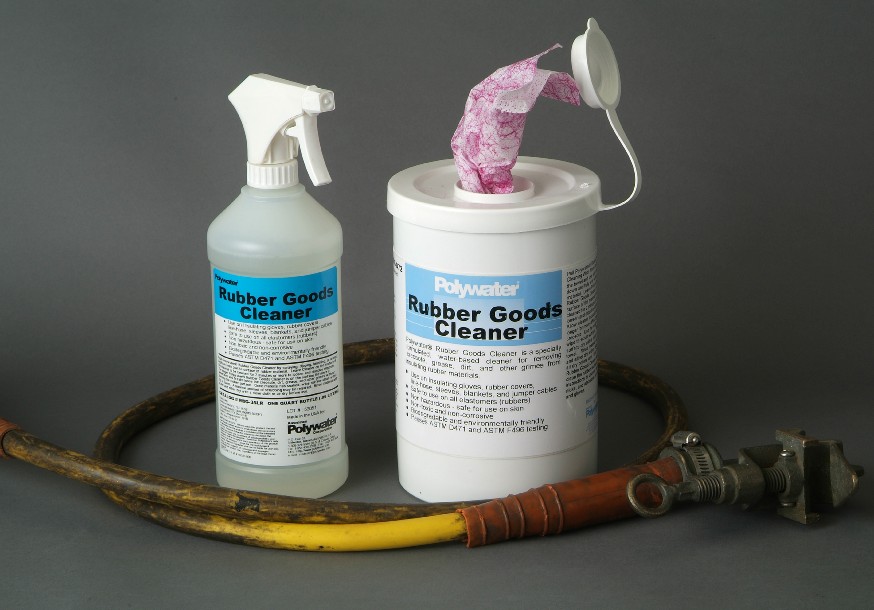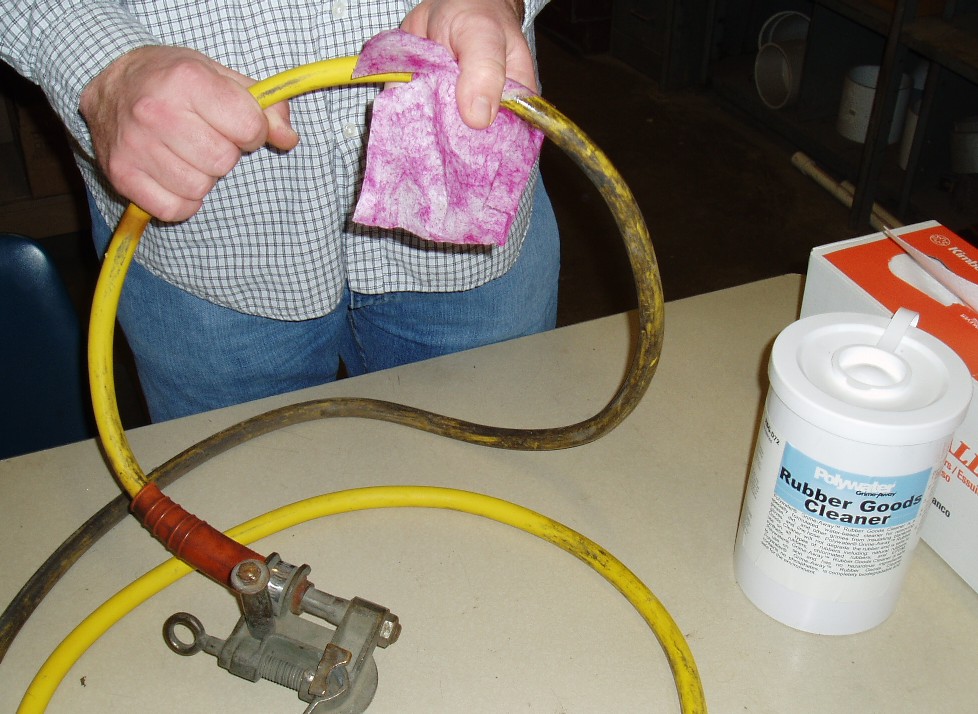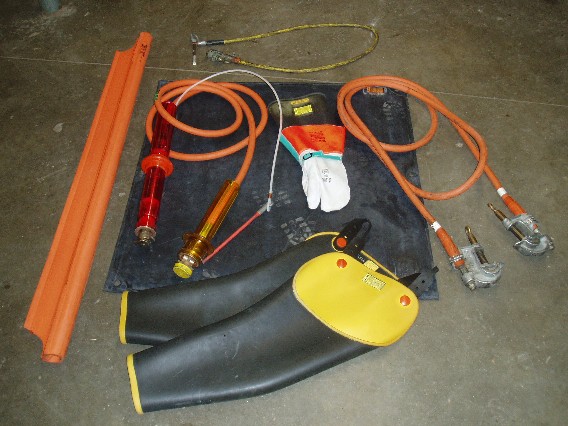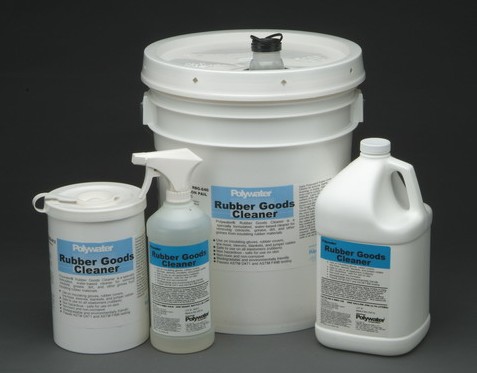
 | Home | Products | Representatives | Resources | SDS | Contact |
| Polywater Support Page |
|
Polywater® Cleaner A specially formulated water-based cleaner for removing dirt, grease, and grime from lineman’s gloves, sleeves, jumper cables, and other rubber goods. |
 |

Description
Polywater® Rubber Goods Cleaner is a specially formulated water-based cleaner for removing grease, dirt, carbon, creosote, and other grimes from insulating blankets, lineman’s gloves, rubber sleeves, jumper cables, hot jumpers, and line-hose. Rubber Goods Cleaner is safe for use on all natural and synthetic rubbers. Unlike other water-based rubber cleaners, Rubber Goods Cleaner contains no hazardous ingredients and is pH neutral, making it safe for use on skin. Rubber Goods Cleaner is also completely biodegradable and safe for the environment.
TESTIMONIAL: "Great product. Works better than the cleaner we are currently using. No harsh chemical to deal with."
Advantages
|
Physical Properties
| Rubber Property-Effect of Liquids (ASTM D471): | Passes all tests |
| Specification for In-Service Care of Insulating Gloves and Sleeves (ASTM F496): | Passes all tests |
| Flashpoint (ASTM D 93): | No flash via TCC |
| Initial Boiling Point: | ~212°F/100°C |
| pH: | Neutral |
| Cleaning Strength: | Excellent |
Usage Directions
Rubber Goods Cleaner LIQUID
Apply Polywater® Rubber Goods Cleaner by spraying, dipping, brushing, or wiping. Evenly coat rubber surface with cleaner. Leave Rubber Goods Cleaner on the surface of the material to be cleaned for 2 minutes or more to loosen and dissolve deposits. Allow cleaner to soak material longer for more difficult grimes. The longer Rubber Goods Cleaner is on the surface the more it penetrates and breaks loose the creosote, dirt, grease, oils and other grimes without harming the rubber surface. Once material has soaked, wipe surface clean with a rag or towel. A minimal amount of scrubbing may be required. Rinse material with water and either dry, with a clean cloth or air dry before use. Use Rubber Goods Cleaner daily to clean the rubbers surface for visual inspections to uncover burns, cuts, nicks, crush points, and abrasions on equipment and gloves.
Rubber Goods Cleaner WIPE
Pull Polywater® Rubber Goods Cleaning Wipe from canister, open the towel and use soft side to wipe down and fully wet surface of material. Leave Rubber Goods Cleaner on the surface of the material to be cleaned for 2 minutes or more to loosen and dissolve deposits. Allow cleaner to soak material longer for more difficult grimes. The longer Rubber Goods Cleaner is on the surface the more it penetrates and breaks loose the creosote, dirt, grease, oils and other grimes without harming the rubber surface. Use the rough side of the wipe to scrub surface. Wipe surface clean with another Rubber Goods Cleaner towelette. Rinse material with water and either dry with a clean cloth or air dry before use. Use Rubber Goods Cleaner daily to clean the rubber’s surface for visual inspections to uncover burns, cuts, nicks, crush points, and abrasions on equipment and gloves.
Watch Streaming Video on Rubber Goods Cleaner usage.
Safe LIVE-LINE Equipment Practices and Cleaning
| Proper protection and performance of rubber protective equipment requires a detailed visual inspection before each use, careful handling of equipment during use, thorough cleaning, periodic electrical testing, and proper storage of equipment after use. Visual inspection of rubber covers, line-hose, rubber gloves, rubber sleeves, insulating blankets, and jumper cables should be performed before each use in accordance with ASTM F1236 #8220;Standard Guide for Visual Inspection of Electrical Protective Rubber Products.#8221; Rubber protective equipment should be checked for:
|

|
 |
Cleaning of rubber protective equipment is necessary not only for visual inspections but to preserve the protective equipment’s electrical integrity, protection, and to add to the life of the equipment. Creosote, dirt, grease, and other contaminants can be conductive, especially when combined with moisture from rain, snow, and fog. Protective equipment should be cleaned daily and whenever it appears dirty with contaminants. Strong industrial cleaners and solvents such as petroleum distillates and d-Limonene may cause permanent damage to the rubber protective equipment. These products may cause rubbers to swell, soften, and lose electrical insulating properties. EPDM rubber is used for protective equipment because it has excellent resistance to ultraviolet light, ozone, and oxidants, but it has poor solvent resistance, making it susceptible to chemical damage. Rubber Goods Cleaner contains no solvents and is an ideal product to use because it is safe to use on all rubber products, including: covers, line-hose, gloves, sleeves, and insulating blankets. Daily use of Rubber Goods Cleaner makes inspection of protective equipment easier and helps to maintain the electrical insulating properties of the equipment. |
Safety
Polywater® Rubber Goods Cleaner has a low level of toxicity and is environmentally friendly. Good industrial hygiene practice and appropriate precautions should be employed during use. See MSDS for specific details.
Compatibility
Polywater® Rubber Goods Cleaner is compatible with plastics and elastomers. Testing is based on soak test described in ASTM D471, Standard Test Method for Rubber Property-Effect of Liquids. Immersion will affect sensitive materials more than incidental contact of a spray and wipe would.
| IMMERSED 72 HOURS AT 122°F (50°C) | |||
|---|---|---|---|
| Elastomers (rubber) | Polywater® RBG™ | ||
| % Weight Change | Appearance | ||
| EPDM | NC | NC | |
| EPDM (type II) blanket | NC | NC | |
| EPDM gloves | NC | NC | |
| EPDM (type II) line hose | NC | NC | |
| Natural rubber | NC | NC | |
| Natural rubber (type I) blanket | NC | NC | |
| Natural rubber (type I) gloves | NC | NC | |
| SALCOR® (type II) blanket | NC | NC | |
| Silicone | NC | NC | |
| IMMERSED 28 DAYS AT 70°F (21°C) | |||
|---|---|---|---|
| Elastomers (rubber) | Polywater® RBG™ | ||
| % Weight Change | Appearance | ||
| EPDM | NC | NC | |
| EPDM (type II) blanket | NC | NC | |
| EPDM gloves | NC | NC | |
| EPDM (type II) line hose | NC | NC | |
| Natural rubber | NC | NC | |
| Natural rubber (type I) blanket | NC | NC | |
| Natural rubber (type I) gloves | NC | NC | |
| SALCOR® (type II) blanket | NC | NC | |
| Silicone | NC | NC | |
| KEY: | |||
| NC=NO CHANGE | C=CRAZING | SS=SLIGHT SWELLING | |
| D=DISSOLVED | S=SWELLING | ES=EXTREME SOFTENING | |
| SALCOR® is a trademark of W.H. Salisbury & Co | |||
Protective Equipment Testing
Protective rubber gloves were exposed to Polywater® Rubber Goods Cleaner as described and sent to an independent NAIL® for PET (North American Independent Laboratories for Protective Equipment Testing) accredited laboratory for testing in accordance with ASTM F496 Standard Specification for In-Service Care of Insulating Gloves and Sleeves. Gloves and sleeves are first washed and dried at the testing laboratory. The items are then inflated and carefully inspected for cuts, tears, punctures, scratches, abrasions, or any other conditions that could adversely affect the dielectric integrity of the item. If any of these conditions are present, the item fails the visual inspection and is rejected and immediately rendered unusable. Gloves, sleeves, and blankets then undergo an electrical test as specified by the "class rating" of the item and the ASTM and OSHA Standards (maximum 40kv A.C.). Again, any item that fails the electrical test is rejected.
| ASTM F496-99 Test Results for Lineman's Gloves | |||||
|---|---|---|---|---|---|
| Class | Type | Exposure | Solvent | Visual Check | Electrical Test (max 40kv A.C.) |
| 00 | 1 | Surface Wipe | RBG | Pass | Pass |
| 00 | 1 | 24-hour Soak | RBG | Pass | Pass |
| 00 | 2 | Surface Wipe | RBG | Pass | Pass |
| 00 | 2 | 24-hour Soak | RBG | Pass | Pass |
| 0 | 2 | Surface Wipe | RBG | Pass | Pass |
| 0 | 2 | 5-minute Soak | RBG | Pass | Pass |
| 0 | 2 | 24-hour Soak | RBG | Pass | Pass |
| 1 | 1 | Surface Wipe | RBG | Pass | Pass |
| 1 | 1 | 5-minute Soak | RBG | Pass | Pass |
| 1 | 1 | 24-hour Soak | RBG | Pass | Pass |
| 2 | 1 | Surface Wipe | RBG | Pass | Pass |
| 2 | 1 | 24-hour Soak | RBG | Pass | Pass |
| CATALOG NUMBERS | ||||
|---|---|---|---|---|
| RBG | Package Size® | Units/CS | Image | |
| RBG-D72 | 72-count saturated wipe dispenser | 6 |  | |
| RBG-1 | Individual saturated wipe | 144 | ||
| RBG-35LR | 1-quart (.95 liter) bottle with sprayer | 12 | ||
| RBG-128 | 1-gallon (3.8 liters) bottle | 4 | ||
| RBG-640 | 5-gallon (18.9 liters) pail | 1 | ||
Important Notice: The statements and information here are made in good faith based on tests and observations we believe to be reliable. However, the completeness and accuracy of the information is not guaranteed. Before using, the end-user should conduct whatever evaluations are necessary to determine that the product is suitable for the intended use. The user assumes all risks and liability in connection with such use. The statements contained herein are made in lieu of all warranties, express or implied, including, but not limited to, implied warranties of merchantability and fitness for a particular purpose, which warranties are hereby expressly disclaimed. American Polywater's only obligation shall be to replace such quantity of the product proven to be defective. Except for the replacement remedy, American Polywater shall not be liable for any loss, injury or damage, direct or indirect, arising from the use or the failure to properly use these products, regardless of the legal theory asserted. The foregoing may not be altered except by a written agreement by the officers of American Polywater Corporation.
View flyer in PDF Format or Français or Chinese
Click here for an MSDS on this product
Click here to Add Your Name To Our Mail List
Click here to Request a Quote on This Product
Click here to view a Streaming Video clip on this product
Click here for an RBG Product Approval from Salisbury by Honeywell
View the Visual Test Results from an Asian utility's evaluation of RBG
Read our article: "Cleaning Rubber Goods for Safety" from Incident Prevention Magazine
Click here to view the Technical Talk Newsletter article on live-line tool performance problems
View our other live-line safety products: Hotstick Treatments and Boom Truck Cleaners and Fiberglass Wax

This website uses third party cookies to analyze navigation and to improve the quality of the user experience. Address: 11222 60th Street N, Stillwater, MN 55082, USA Phone: +1 651 430-2270 | Fax: +1 651 430-3634 | Phone: 800 328-9384 (Toll-Free USA/Canada) General Email: Email Contact Page |